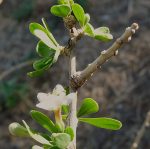 Also called European tea-tree, this deciduous shrub native to Mediterranean shrublands, is a member of the nightshade family, Solonaceae, that also includes tomato, eggplant, and tobacco. The spreading many branched plant grows up to 13′ tall and has an extensive root system and light brown hairless stems that darken and becomes fissured with maturity. The stems have spines up to 3/4-6″ long , depending on age, and each small side branch ends with a spine. The lanceolate leaves are alternate, entire, and 3/4-2″ long. The fragrant, tubular flowers usually appear singly in summer. They have 5 lobes and are pink, violet or greenish-yellow. The fruit is a red or orange fleshy berry about 1/3″ in diameter. Photo Credit Wikipedia
Also called European tea-tree, this deciduous shrub native to Mediterranean shrublands, is a member of the nightshade family, Solonaceae, that also includes tomato, eggplant, and tobacco. The spreading many branched plant grows up to 13′ tall and has an extensive root system and light brown hairless stems that darken and becomes fissured with maturity. The stems have spines up to 3/4-6″ long , depending on age, and each small side branch ends with a spine. The lanceolate leaves are alternate, entire, and 3/4-2″ long. The fragrant, tubular flowers usually appear singly in summer. They have 5 lobes and are pink, violet or greenish-yellow. The fruit is a red or orange fleshy berry about 1/3″ in diameter. Photo Credit Wikipedia
There are many spiny plants mentioned in the Bible. The Hebrew word צנ has been identified as boxthorn by some scholars but is usually translated simply as thorns or brambles.
Proverbs 22.5 (NKJV) The verse deals with practical morality noting that discipline can help avoid the dangers of life.
“Thorns and snares are in the way of the perverse; He who guards his soul will be far from them.”
Judges 9 (NKJV) The Hebrew word is translated as bramble in Jotham’s Parable of the Trees
14. Then all the trees said to the bramble, ‘You come and reign over us!’
15. And the bramble said to the trees, ‘If in truth you anoint me as king over you, then come and take shelter in my shade; But if not, let fire come out of the bramble and devour the cedars of Lebanon.
Boxthorn likes full sun and average, moist, well-drained soil but tolerates lean soil and maritime exposure in USDA Hardiness zones 8-11. It has no significant pests or diseases. Propagation is by seed, mature cuttings from autumn to late winter, layering, and division.
The genus name, Lycium, comes from the name of an ancient city in Asia Minor and was used by the ancient Greeks and Romans for some thorny shrub or tree. The specific epithet, europaenum, suggests the distribution of the plant in Europe.